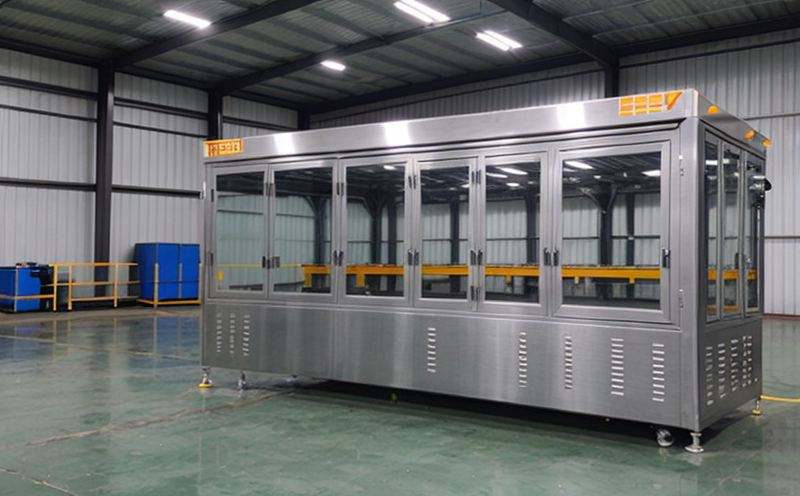ASTM B117-18 Salt Fog Testing
The ASTM B117-18 Salt Fog Test is a standard protocol designed to evaluate the resistance of metallic materials, coatings, and surface treatments against atmospheric corrosion by salt fog. This test simulates an environment where metal packaging may be exposed to corrosive conditions such as those found in shipping containers or storage facilities.
The test procedure involves exposing the specimen to a controlled atmosphere containing a fine mist composed primarily of sodium chloride (NaCl) and water under specific humidity and temperature conditions. The purpose is to accelerate the corrosion process, allowing for accelerated aging and testing of materials’ durability under harsh environmental conditions.
For metal packaging, this test helps in identifying potential weaknesses or failures that could compromise the integrity of the package during storage or transport. By understanding these vulnerabilities early on, manufacturers can improve their product design and ensure compliance with regulatory standards.
The ASTM B117-18 salt fog testing process is critical for industries reliant on metal packaging, such as food, pharmaceuticals, cosmetics, and electronics. The test ensures that the chosen materials or coatings provide adequate protection against corrosion, maintaining both functionality and safety throughout their lifecycle.
Understanding the nuances of ASTM B117-18 requires familiarity with its technical specifications. This includes knowledge about the salt solution concentration (5% NaCl), temperature control within a range of 35°C ±2°C, relative humidity maintained at ≥95%, and exposure duration which varies based on the material being tested.
The test setup typically consists of an environmentally controlled chamber where samples are suspended vertically or horizontally. A fine mist of saltwater is continuously injected into the chamber through nozzles positioned around its perimeter. The mist remains in suspension until it condenses on the surface of the specimen, creating a continuous film that simulates atmospheric conditions.
Specimen preparation involves selecting representative samples that accurately reflect the intended use and expected environmental exposure. These samples are then cleaned thoroughly using appropriate methods to remove any contaminants or residues before being placed inside the test chamber.
The results from ASTM B117-18 salt fog testing provide valuable insights into a material’s performance under corrosive conditions. Key metrics include rust formation, blistering, pitting, and overall degradation observed over time. Compliance with industry standards ensures consistent quality across batches of products while also supporting regulatory requirements.
Understanding the ASTM B117-18 salt fog testing process is essential for those involved in developing new materials or coatings for metal packaging applications. It allows them to make informed decisions regarding material selection, formulation adjustments, and production processes aimed at enhancing product longevity and reliability.
Applied Standards
The ASTM B117-18 Salt Fog Test adheres strictly to the guidelines outlined in ASTM Standard Practice E1654-03(2019). This standard provides detailed instructions on how to conduct salt fog testing according to established protocols. Compliance with these standards ensures accurate and consistent results across different laboratories.
Other relevant standards that may influence metal packaging design include ISO 9227 (formerly known as EN 5068) for general information on atmospheric corrosion testing, and ASTM D1654-16 for evaluating resistance to salt spray corrosion of painted or coated metals used in automotive applications.
By adhering to these standards, manufacturers can ensure their products meet necessary quality benchmarks set forth by regulatory bodies. This not only enhances product reliability but also fosters trust among consumers who rely on safe and effective packaging solutions.
Industry Applications
- FDA regulations for pharmaceuticals requiring shelf stability over extended periods.
- EU directives governing the transport of hazardous materials via road, rail, or air.
- Standards set by international food safety organizations like Codex Alimentarius for perishable goods.
- Regulations enforced by U.S. Customs and Border Protection for import/export compliance.
The ASTM B117-18 salt fog test plays a crucial role in ensuring that metal packaging meets these stringent requirements, thereby protecting both the integrity of the product inside and maintaining consumer confidence.
Use Cases and Application Examples
| Industry Sector | Description | Test Parameters |
|---|---|---|
| Packaging Development | Evaluating the effectiveness of different coating systems. | Exposure time: 168 hours; Salt concentration: 5% NaCl. |
| Quality Assurance | Detecting early signs of corrosion on newly manufactured packaging. | Environmental chamber parameters: Temperature -35°C ±2°C, Humidity ≥95%, Duration: Variable. |
| R&D Engineering | Optimizing material composition and surface treatments. | Sample preparation: Cleaned specimens; Exposure duration: 720 hours. |
| Procurement | Vetting suppliers based on their adherence to industry standards. | Acceptance criteria: No visible rust or blistering after exposure. |
The table above highlights various use cases where ASTM B117-18 salt fog testing is applied. Each scenario demonstrates how this standardized test contributes to improving product quality and ensuring compliance with relevant regulations across different industries.





